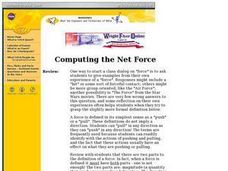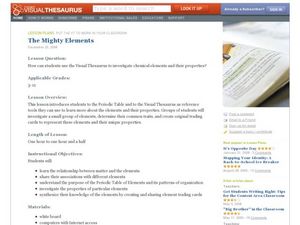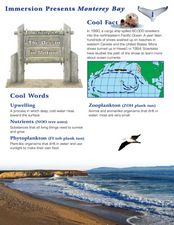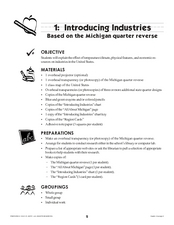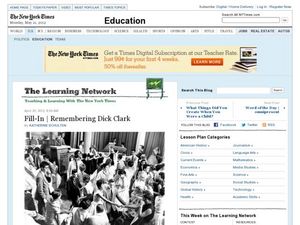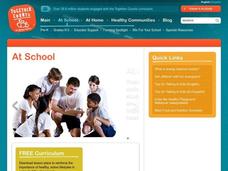Teaching Tolerance
Changing Demographics: What Can We Do to Promote Respect?
America has always been seen as a melting pot to the world. Scholars research the concept of blending cultures in the United States and how it is changing over time. The final lesson of a four-part series analyzes the changing...
Reed Novel Studies
Hatchet: Novel Study
Thanks to Gary Paulsen's Hatchet, teen readers now know it's possible to survive in the wilderness. A study guide for the novel discusses common topics and vocabulary words found within the text. Additionally, readers get the chance...
Serendip
Evolution of Fur Color in Mice – Mutation, Environment and Natural Selection
Most species of animals include a variety of fur or hair color, but why? Scholars watch a video about a changing environment for mice. As the rocks around them change hues, different colors of mice begin to thrive. Discussion questions...
Cold Spring Harbor Laboratory
Mendelian Laws Apply to Human Beings
Why are so many inherited diseases more prevalent in populations of specified races? Scholars learn about pedigrees and genetics using a reading, an animation, primary sourced letters, a short video, a biography, a guided practice...
Curated OER
Computing the Net Force
Adorable little stick figures push and pull a cart of blocks to explain the push and pull of forces. Future physicists then define force and identify it in different situations on the learning exercise that follows. Concepts covered...
Curated OER
2nd Grade - Act. 05: Olympics
Learn more about the Olympics with your 2nd graders. Using a variety of resources, your class will learn about healthy bodies, training, and eating properly. Additionally, they will discover various Olympic activities and the athletes...
Curated OER
Chasing Metaphors
Students use metaphors in order to see commonly experienced objects, events, and people in new and more meaningful ways.
Curated OER
Sexually Transmissible Diseases (STDs) - Day 1: Overview
Pages and pages of information on sexually transmissible diseases (STD). Vocabulary, worksheets, reference sheets, questions for discussion, and more. Transmission and reducing the risk of transmission of a STD. Signs, symptoms, and...
PBS
The History and Use of Sampling Methods
Young mathematicians define population, draw convenience sample from the population, draw quota sample from the population, and draw random probability sample from the population. They explain why a random probability sample usually...
Curated OER
Exploring Learned and Innate Behavior
Middle schoolers explore the differences between learned and innate behavior among humans and monkeys. They complete an assignment and read articles about two studies, which used similar test methods to show that infants and monkeys...
Curated OER
Dance Sequences and Phrases
A series of lessons about dance would be a great addition to your physical education class. Straightforward as well as creative, it teaches the basic skills of dance movement. A rubric helps guide the dancers to let them know what steps...
Curated OER
The Mighty Elements: Using the Visual Thesaurus to Investigate Chemical Elements
Pupils create trading cards for elements in the Periodic Table. Initially, they are introduced to the Periodic Table of Elements and the concept of elements in the world around us. After dividing into groups, learners use the Visual...
Curated OER
School Forest
Sixth graders explore the concept of biodiversity. In this biodiversity lesson, 6th graders discover a variety of planets and animals that live in forests, and how a rotting log benefits that environment. Students also locate...
Curated OER
Survival Still
Lead your class to construct a solar still on campus to demonstrate how water can be extracted from the soil. The power of solar energy is emphasized, as is the concept of how capillary water can be recovered and purified by using a...
Curated OER
Monterey Bay
Learners read background information about Monterey Bay, California, and conduct related experiments. In this ocean in motion instructional activity, students read information about the location, wildlife, and characteristics of Monterey...
Curated OER
Introducing Industries
If you are looking for a way to explore Michigan's resources, physical features, and more, this lesson is for you. After discussing Michigan and the Great Lakes, learners fill out a graphic organizer identifying the state's natural...
Curated OER
L.O. Calculating Area and Perimeter (Version 2)
An excellent presentation on calculating area and perimeter. Young mathematicians practice the skills involved with determining the area and the perimeter of a variety of rectangular shapes. The final two slides present a challenging...
Curated OER
Spelling - Adding -ing to Verbs
In this language arts presentation, learners are coached on the proper ways, and proper times, to add -ing to a verb. Clear instructions, and engaging examples are embedded in each slide. A very good PowerPoint to use when teaching this...
Curated OER
Fill-In l Remembering Dick Clark
Your scholars may have an idea of who Dick Clark is, but do they understand the role he has played in American history for over 50 years? Give learners some practice with media literacy as they read an article about Clark's life and fill...
Curated OER
Language Variation: Sociolinguistics and Dialectology
Sociolect? Jargon? Morphosyntactic? Labov? Ebonics? The fifteen slides in this presentation serve to introduce terms and concepts used in the discussion of how ethnicity, age, social class, education, religion, and gender influence...
Curated OER
Introduce Vocabulary: Some Birthday! (Polacco)
Patricia Polacco weaves an engaging tale for budding readers in her book Some Birthday!, an excellent resource for vocabulary in context. You can use this text to introduce the following words: investigate, snarl, and squawk....
Curated OER
Maniac Magee: Picture Book Strategy
Who would have thought to explore the concept of race through children's literature? After reading Bell Hooks' picture book, Skin Again, and chapter sixteen of Jerry Spinelli's Maniac Magee, class members...
Curated OER
Energy Balance In Your Life
It's easy enough to put energy in, but not so easy to use it up! Look at food labels with your young learners and help them understand the concept of calories in and calories out. Food eaten means calories in and exercise means calories...
ARKive
Adaptation: Design a Species
Adapt is what an animal does to ensure it will survive in a specific environment; maybe it's more complicated than that. Your young animal experts can view this handy presentation to better understand animal adaptations and also complete...




